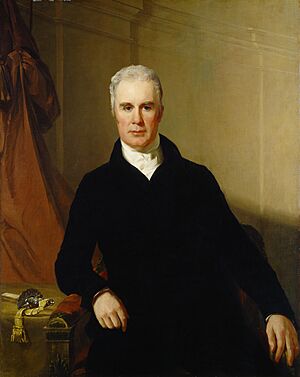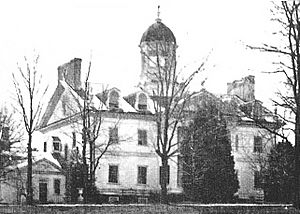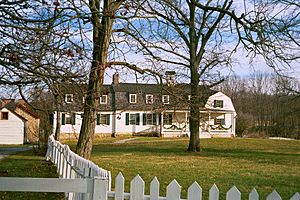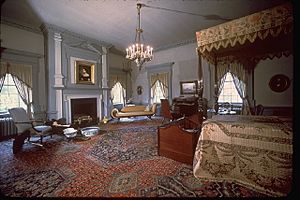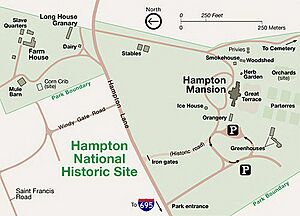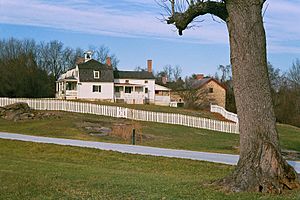Hampton National Historic Site facts for kids
Quick facts for kids Hampton National Historic Site |
|
|---|---|
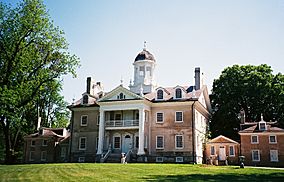 |
|
| Location | Baltimore County, Maryland, USA |
| Nearest city | Baltimore, Maryland |
| Area | 62.04 acres (25.11 ha) |
| Established | June 22, 1948 |
| Visitors | 14,612 (in 2023) |
| Governing body | National Park Service |
| Website | Hampton National Historic Site |
Hampton National Historic Site is a special place in Maryland, north of Towson. It protects a small part of a huge estate from the 1700s. This site includes a beautiful Georgian-style mansion, lovely gardens, and the original stone buildings where enslaved people lived.
The Ridgely family owned this estate for seven generations, from 1745 to 1948. The Hampton Mansion was the biggest private home in America when it was finished in 1790. Today, it is a top example of Georgian architecture in the United States. The mansion's furniture, along with the preserved slave quarters and other buildings, show us what life was like for wealthy landowners in the late 1700s and early 1800s.
In 1948, Hampton became the very first National Historic Site chosen by the U.S. National Park Service. It was recognized for its amazing architecture. The gardens were famous in the 1800s for their fancy designs. They have been restored to look like they did in the 1820s. Some trees on the property are over 200 years old! Visitors can also explore the overseer's house and the slave quarters. Hampton is one of the few plantations where the original slave quarters still stand today.
Contents
A Look Back: Hampton's Story
How Hampton Began (1700s)
The land where Hampton stands was first given to Col. Henry Darnall in 1695. His family sold the land in 1745 to Col. Charles Ridgely. He was a tobacco farmer and trader. The sale papers mentioned that the property already had houses, tobacco barns, stables, gardens, and orchards.
By the late 1750s, Hampton was a huge estate, covering more than 10,000 acres. It even had an ironworks. Charles Ridgely's son, Capt. Charles Ridgely, made the family business even bigger. He added gristmills (for grinding grain), apple orchards, and stone quarries. During the American Revolutionary War, the ironworks made cannons and ammunition for the Continental Army. This brought a lot of money to the Ridgely family.
In 1783, Capt. Ridgely started building the main house, Hampton Mansion. He said it was inspired by Castle Howard in England. When it was finished in 1790, Hampton Mansion was the largest private home in the United States. Capt. Ridgely died that same year. His nephew, Charles Carnan Ridgely, became the second owner of Hampton. He added irrigation pipes in 1799 to bring water to the mansion and its growing gardens. Famous artists were hired to design the beautiful formal gardens, which were planted between 1799 and 1801. Charles Carnan also loved horses and started raising Thoroughbred horses at Hampton. He even had a racetrack!
Life at Hampton's Peak (1800s)
Under Charles Carnan Ridgely, Hampton grew to its largest size, about 25,000 acres, in the 1820s. The mansion looked out over a grand estate with orchards, an ironworks, coal mines, marble quarries, mills, and shops. The large farm produced corn, beef, dairy products, hogs, and horses. More than 300 enslaved people worked on the farm and in the mansion. This made Hampton one of Maryland's biggest slaveholding estates.
The gardens had six fancy sections called parterres on three levels, filled with roses, peonies, and seasonal flowers. In 1820, a special greenhouse for citrus trees, called an orangery, was built.

Charles Carnan Ridgely often hosted important guests in the mansion's Great Hall. These guests included Charles Carroll of Carrollton, who signed the Declaration of Independence, and Revolutionary War general, the Marquis de Lafayette. Charles Carnan was also the governor of Maryland from 1816 to 1819. When he died in 1829, his will stated that the enslaved people at Hampton should be freed.
The Hampton estate was then divided among his children. His son, John Carnan Ridgely, inherited the mansion and about 4,500 acres. The ironworks closed, and the family's money mostly came from farming, investments, and their stone quarries. John Carnan added modern plumbing, heating, and gas lighting to the mansion.
John's wife, Eliza Ridgely, bought many artworks and furnishings for the mansion. She was a skilled gardener and created even larger and more beautiful gardens. She grew many different flowers and shrubs in the estate's greenhouses. Some of the 60 enslaved people bought by John Carnan Ridgely helped tend these gardens. By the mid-1800s, Hampton had one of the largest collections of citrus trees in the U.S. Eliza also brought exotic trees and plants from her travels to Europe and Asia. In warm weather, the potted citrus plants were placed around the terraced gardens. In winter, they were moved into the heated orangery. In 1859, Hampton was so famous for its grand style that a book on landscaping said it showed "more grandeur than any other place in America."
In January 1861, after Abraham Lincoln became president, Charles Ridgely (John and Eliza's son) started a pro-Confederate militia group at Hampton. One of his men was arrested, leading to a famous court case. Even though the Civil War was fought nearby, the Hampton estate was not damaged.
Maryland was a border state and was not included in Lincoln's Emancipation Proclamation. However, Maryland ended slavery in 1864. After slavery ended, Hampton began to struggle. Some formerly enslaved people stayed to work as paid servants, but the Ridgelys had to hire other workers for the farm. When John and Eliza died in 1867, their son Charles became the next owner. After Charles died in 1872, Captain John Ridgely inherited the mansion and the remaining 1,000 acres. Important guests, like Theodore Roosevelt, continued to visit Hampton.
Hampton in Modern Times (1900s)
As the city of Baltimore grew, it became harder for the Ridgely family to keep up the large property. Five of the six fancy garden sections were removed and replaced with grass. The family made some money by selling cider from their apple orchards and running a dairy farm. In 1929, Capt. John Ridgely and his son, John Ridgely Jr., sold some of the remaining land for housing developments.
In 1938, John Ridgely Jr. became the sixth generation of the family to own Hampton. His company sold large parts of the estate for suburban homes in the 1930s and 1940s. This area is now known as the Hampton residential community. The Hampton Mansion stayed in the Ridgely family until 1948. That year, John Ridgely Jr. moved to the smaller Farm House on the property. The Avalon Foundation bought the mansion.
The Hampton Mansion and its remaining 43 acres became a National Historic Site on June 22, 1948. It was the first site chosen for its historical importance and amazing architecture. The mansion opened to the public in May 1949. Work also began to restore four of the 19th-century garden sections. In 1966, Hampton was added to the National Register of Historic Places. In 1979, the National Park Service (NPS) took over managing the estate. The NPS later bought more land, bringing the park to its current size of 62.04 acres.
Hampton Today (2000s)
In 2000, the NPS began studying the mansion's security, safety, and electrical systems. They found that the mansion needed a fire safety system and better climate control to protect its old furnishings and paintings. The NPS made plans in 2004 to install a modern heating and cooling system and a hidden fire sprinkler system. This would protect the historic mansion and its valuable items from fire.
From January 2005 to November 2007, the mansion closed for a big restoration project. During this time, the drawing room and two bedrooms were completely redone. The furnishings were carefully researched to look exactly like they did between 1830 and 1860. The fancy dome on top of the mansion, called a cupola, was also restored. The Hampton Mansion reopened to the public on November 30, 2007.
The chief ranger for Hampton National Historic Site said the $3 million renovations made the mansion look better than ever. A group called "Preservation Maryland" gave Hampton National Historic Site an award in 2007. They recognized the site for restoring the mansion's rooms with historical accuracy while also adding modern safety systems.
Recently, there have been discussions about how the National Park Service shares the history of places like Hampton. Historians want to make sure that the stories of all people who lived and worked there, including enslaved people, continue to be told.
Visiting Hampton National Historic Site
The 62.04-acre estate is now managed by the National Park Service and is open to everyone. There is free parking and the mansion is wheelchair accessible. Visitors can take a guided tour of the mansion. Inside, you can see the original furniture, oil paintings, silverware, and ceramics owned by the Ridgely family. There are about 7,000 objects in total!
Besides the mansion, you can see nine other original buildings from the 1700s and mid-1800s:
- Farm House – This house is north of the mansion, next to the slave quarters. Part of it might be older than when the Ridgelys bought the land in 1745. The Ridgely family lived here while the mansion was being built. Later, it was home to the farm manager. John Ridgely Jr. and his wife lived here after moving out of the mansion in 1948.
- Slave quarters – These are two preserved stone buildings next to the Farm House. They have exhibits that teach about the lives of enslaved people at Hampton. The stone came from the Ridgelys' own quarry. The difference between these simple quarters and the grand mansion is very clear. You can see an old newspaper ad where Charles Carnan Ridgely offered a reward for a runaway enslaved person. There's also a Christmas gift list for the children of enslaved people from 1841 to 1854.
- Dairy – This stone building was built before 1800.
- Mule barn – A stone barn built around 1845.
- Long house/granary
- Ash house, wooden log building, and dovecote
You can also take self-guided tours of the grounds. These include the farm, formal garden, family cemetery, and two stone stables for the Ridgely family's thoroughbred horses. A copy of the original orangery (built in 1824) can also be seen. The original wooden orangery burned down in 1926, but a new one was built on the old foundations in 1976. A 34-foot deep underground icehouse is near the mansion and is open to visitors.
Some of the trees planted by the Ridgelys in the 1820s are still there. These include a large tulip tree, a European Beech, and Catalpas. A special Cedar of Lebanon, brought as a seedling from the Middle East by Eliza Ridgely, is one of the largest in the U.S.
Many special events happen throughout the year. These include chamber music concerts and harpsichord performances in the mansion's Great Hall. There are also milking demonstrations at the dairy, carriage rides, and blacksmithing demonstrations. In 2008, Hampton had 35,000 visitors.
A local group called "Historic Hampton" helps the National Park Service preserve the site. They help make sure the interiors are historically accurate and support various activities. The National Park Service also keeps Ridgely family papers from 1750 to 1990 for researchers.
The Tea Room's Story
When the Hampton estate first opened to the public in 1949, the mansion's kitchen became a small restaurant. It was called the Tea Room and was run by a company for 50 years. It served lunches with delicious seafood, like Hampton Imperial Crab, and other local dishes. A newspaper writer described the Tea Room as "offering gentility" with a big fireplace and thick windows.
The National Park Service closed the Tea Room on January 1, 1999. Officials said they closed it because of the risk of fire from having a kitchen in the main building. They also worried about insects or rodents damaging historic items. The Park Service said that while a meal might be pleasant, it was more important to protect Hampton's buildings and objects for the future. Groups like Preservation Maryland were disappointed, saying the restaurant helped attract visitors. Since 2006, some groups have tried to get the Tea Room reopened, believing it would bring more visitors. However, a Park Service spokesman said in 2006 that "The mansion is not going to be the site of any food operation."




